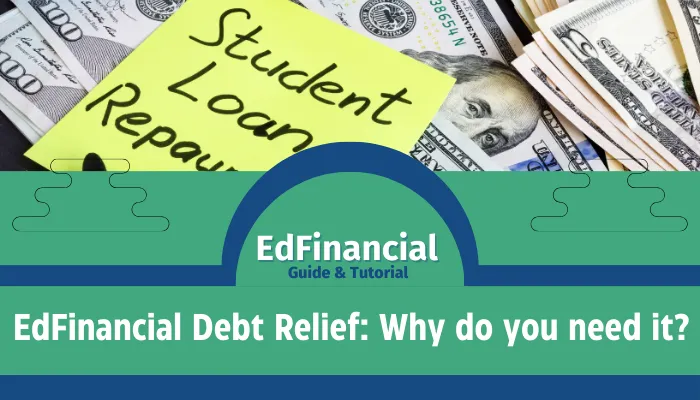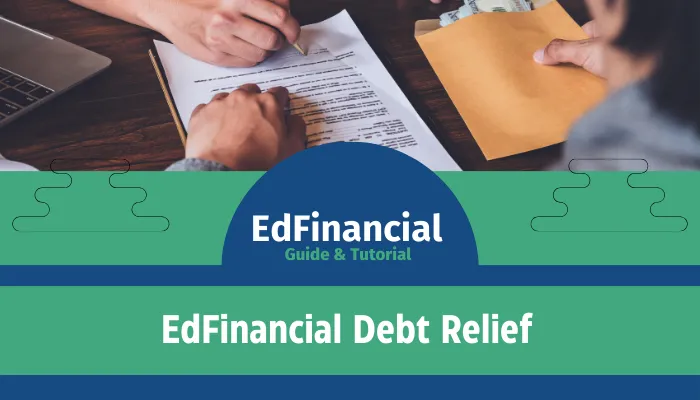EdFinancial debt relief is a beacon of hope for countless borrowers struggling with student loan debt. Do you feel like you’re drowning in student loan debt serviced by EdFinancial? You are not alone. Millions of Americans find themselves struggling with educational debts, but there’s some good news: a variety of EdFinancial debt relief options are there to help alleviate financial burden.

Inclusive guide that provides all the discharge options and EdFinancial loan forgiveness programs which might erase some or even all your loans. Let us go this route together and identify the best way for you to achieve freedom from liability!

EdFinancial Debt Relief: Why do you need it?
Before we start discussing the details about the available discharge options, it is important to understand who EdFinancial is and what their role is in your student loan journey. This means that they play a middleman between you and the government where through them they will collect your payment inform of customers’ service.
“Why do I need to know about EdFinancial debt relief?” you may ask yourself. When it comes to dealing with these loans that have been serviced by edfinancial, one has to get a complete understanding such as their policies as well as federal programs administered by them. They handle everything concerning your loans from payments made up to forms of forgiving them.

EdFinancial Debt Relief
By many borrowers, this cannot be seen anywhere else apart from just an empty dream; it can really happen! Therefore, let’s break down various types of discharging available for learning if it suits you or not.
1. Public Service Loan Forgiveness (PSLF)
All those working in public sector or non-profit organization should pay attention! Public Service Loan Forgiveness program may lead you towards being forgiven by Edfinancial.
Here’s how it works:
- Work full-time for a qualifying employer
- Make 120 qualifying monthly payments
- Have Direct Loans (or consolidate into Direct Loans)
- Be on an income-driven repayment plan
After fulfilling these requirements, your remaining Direct Loan balance may be forgiven. That’s what I call EdFinancial debt relief!
But let’s dive a little deeper. What exactly counts as a qualifying employer? Broadly speaking, government organizations at any level (federal, state, local or tribal) and not-for-profit organizations that are tax-exempt under Section 501(c)(3) of the Internal Revenue Code qualify.
2. Teacher Loan Forgiveness
All teachers listen up! If you taught full-time for five consecutive years in a low-income school or educational service agency, you could qualify for Teacher Loan Forgiveness.
By virtue of this scheme, you could obtain up to:
- $17,500 on your Direct Subsidized and Unsubsidized Loans as well as your Subsidized and Unsubsidized Federal Stafford Loans
- $5,000 on your Direct Subsidized and Unsubsidized Loans as well as your Subsidized and Unsubsidized Federal Stafford Loans
Highly qualified mathematics and science teachers at the secondary level or special education teachers at any grade level may be entitled to higher amount of $17,500.
However, one should note that PSLF cannot overlap with Teacher Loan Forgiveness when it comes to counting years of service. However, you might be in a position to go for Teacher Loan Forgiveness first before proceeding towards PSLF which would maximize EdFinancial debt relief opportunities available.
3. Income Driven Repayment Plans (IDR) Plan Forgiveness
EdFinancial’s alternative method of debt relieve is through income-driven repayment plans. You may qualify for forgiveness after making payments over a period ranging from 20 -25 years depending on the type of plan.
There are four IDR plans available:
- Income-Based Repayment (IBR)
- Pay As You Earn (PAYE)
- Revised Pay As You Earn (REPAYE)
- Income-Contingent Repayment (ICR)
Each plan has its own set of rules so it is important to research which option suits you best: here’s a quick breakdown:
- IBR: Payments will usually be 10% or 15% of what’s left after subtracting B from A depending on when you borrowed.
- PAYE: Payments are generally 10% of discretionary income but never more than what would be paid under the 10 year Standard Plan Payment.
- REPAYE: Payments are generally 10% of your discretionary income. PAYE, unlike this plan does not limit the payment amount.
- ICR: Payments will be the lesser of 20% of your discretionary income or the amount you would pay on a repayment plan with a fixed payment over 12 years.
These plans can reduce monthly payments significantly but may end up in paying more over time because of interest that is earned. Nonetheless, such loans become attractive when borrowers consider an opportunity for EdFinancial loan forgiveness at the end of their repayment period.
4. Total and Permanent Disability Discharge
Sometimes life can get rough, and crippling injury may result from any bad fortune. If one finds themselves in such a situation, they might qualify for Total and Permanent Disability (TPD) discharge.
For eligibility, one has to provide evidence from any of the following sources:
- The U.S Department of Veterans Affairs (VA)
- The Social Security Administration (SSA)
- A licensed medical doctor
Once accepted, this choice offered by EdFinancial could write off all federal student loans. It is also significant to note that it might be taxable and there is a three-year monitoring period after discharge which requires certain conditions to be met so as to maintain it.
5. Closed School Discharge
Did your school close while you were enrolled or soon after you withdrew? You might be qualified for a Closed School Discharge. This EdFinancial loan forgiveness option applies if:
- Your school closed while you were enrolled or shortly after you withdrew
- No completion of program due to closure of the institution
- Failure to transfer credits to finish the same or another similar program in another school.
Qualifying for this will mean that all your Direct Loans, Federal Family Education Loan (FFEL) Program loans, and Federal Perkins Loans can be discharged up to 100%. This is therefore an important form of EdFinancial debt relief for those whose institutions closed down leaving them stranded.
It is important to note here that, if eligible for this discharge, there may also be entitlements to reimburse any payments made on these loans. Additionally, having approved a Closed School Discharge may restore federal student aid eligibility.
6. Borrower Defense to Repayment
If your school deceived or committed some unlawful act against any certain state legislator’s law, you may qualify under Borrower Defense to Repayment. Your Direct Loans could potentially be completely wiped off under this EdFinancial debt relief alternative.
To apply you will have submit a case with evidence to support it at the U.S Department Of education office. These could include;
- False claims contained in promotional literature published by the school
- Misrepresentation about job placement rates or transfer credit through emails from school officials
- Testimonial from one of many other students who experienced such kind of misbehavior
Important here is that; this process can be intricate and time consuming; but for such victims of improper acts by schools it gives great means by which Ed Financial loan forgiveness can be achieved.
7. False Certification Discharge
In some cases, schools may fraudulently certify a student’s eligibility for federal student loans. In case this happened to you, you could be qualified for a False Certification Discharge. This applies if:
- The school falsely certified your eligibility to receive the loan
- The school signed your name on the application or promissory note without your permission
- You were eligible, but the school certified your eligibility, although you did not meet the requirements necessary for students.
It should be understood that you had met all student eligibility requirements as certified by the school, however, because of physical or mental condition or age or criminal record or any other reason you were not able to achieve state licensing conditions for the occupation that you were being trained for.
8. Unpaid Refund Discharge
If the required loan funds were not returned by the school to the loan servicer when I withdrew from school; I can still apply for an Unpaid Refund Discharge. The amount will be equal to what was supposed to be refunded by the school.
One of such situations arises when a student seems to withdraw early in the semester and the school is then required to reimburse some portion of the tuition. In case that doesn’t happen, if you have selected this EdFinancial debt relief option, you will not be responsible for the section of loan.
Navigating the EdFinancial Debt Relief Process
Now that we have gone through different options for discharge, let’s talk about how to navigate through them. With proper approach, it may seem overwhelming but it can be tackled step by step.
- Identify Your Loans: Start by logging into your account with EdFinancial and identifying each of your loans. Note down their categories, interest rates and balances. Having this information in place helps in figuring out whether you are eligible for any EdFinancial loan forgiveness programs.
- Research Your Options: Depending on your various types of loans and personal circumstances, think about which ones among the EdFinancial debt relief alternatives are feasible for you. Do not shy away from delving deeper into these – comprehending every subtlety about a certain plan may assist in making the most appropriate financial future choice.
- Gather Documentation: You need relevant documents to support your claim depending on what type of discharge option you are seeking for. This could involve employment records, disability documentation or proof that a school has been closed down. Being organized as well as thorough during this stage can make application process significantly more efficient.
- Contact EdFinancial: Reach out to its customer service department at Edfinancial phone number 800-337-6884 and discuss with them your situation as well as possible courses of action regarding EdFinancial loan forgiveness options that may apply to you too while doing so. Valuable insights can be provided by their representatives who might guide you through this official operation.
- Submit Your Application: Once you know what is best for you, send an application over concerning your chosen discharge option. It is important to avoid delaying the processing by filling out all your forms completely and accurately.
- Follow Up: The EdFinancial debt relief process could take some time to be completed. Therefore, make sure that you follow up on the status of your application frequently. Do not be afraid to keep pushing on – it is your financial future at stake!
- Consider Alternatives: If you are ineligible for any discharges, check out other EdFinancial debt relief strategies like refinancing or consolidation. These are not options for forgiveness but they can help you handle your debts better.
Conclusion
Even though navigating through the world of EdFinancial debt relief might be intricate, being well-informed will help you make prudent judgments concerning your education credits. Whether you are eligible for Public Service Loan Forgiveness, Teacher Loan Forgiveness or any other discharge option, there are ways to decrease your school debts.
Remember this: when it comes to EdFinancial loan forgiveness, it’s not only an imagination but an actual reality for many borrowers. Take your time to understand all choices available to you, collect necessary documents and then commence. The path towards EdFinancial debt relief may be long but worthwhile undertaking. Every single step made moves one closer towards fiscal freedom. Begin now so that tomorrow finds you a step ahead!
